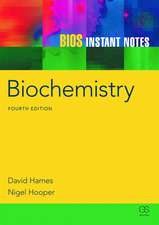Membranes and Sensory Transduction
Autor Giuliano Colombetti, Francesco Lencien Limba Engleză Paperback – 21 ian 2012
Preț: 393.35 lei
Nou
Puncte Express: 590
Preț estimativ în valută:
75.28€ • 78.30$ • 62.15£
75.28€ • 78.30$ • 62.15£
Carte tipărită la comandă
Livrare economică 14-28 aprilie
Preluare comenzi: 021 569.72.76
Specificații
ISBN-13: 9781461296652
ISBN-10: 146129665X
Pagini: 404
Ilustrații: XVIII, 380 p.
Dimensiuni: 152 x 229 x 21 mm
Greutate: 0.54 kg
Ediția:Softcover reprint of the original 1st ed. 1984
Editura: Springer Us
Colecția Springer
Locul publicării:New York, NY, United States
ISBN-10: 146129665X
Pagini: 404
Ilustrații: XVIII, 380 p.
Dimensiuni: 152 x 229 x 21 mm
Greutate: 0.54 kg
Ediția:Softcover reprint of the original 1st ed. 1984
Editura: Springer Us
Colecția Springer
Locul publicării:New York, NY, United States
Public țintă
ResearchCuprins
1 Membranes: Structure and Function.- 1. The Dynamic Structure of Cell Membranes.- 2. Kinetic and Thermodynamic Approach to Membrane Transport Properties.- 3. Transport in Excitable Membranes.- 4. Model Photosensitive Membranes.- References.- 2 Biochemistry of Chemosensory Behavior in Prokaryotes and Unicellular Eukaryotes.- 1. Diversity and Unity in Chemotaxis.- 2. Perception of Chemicals.- 3. Signal Transduction.- 4. Behavioral Responses.- 5. Adaptation and Signal Processing.- 6. Models for Chemotaxis.- 7. Conclusion.- References.- 3 Mechanosensory Transduction in Protozoa.- 1. Introduction.- 2. Depolarizing and Hyperpolarizing Membrane Responses to Mechanical Stimulation.- 3. Ionic Mechanisms of the Mechanoreceptor Responses.- 4. Kinetic Analysis of the Mechanoreceptor Currents.- 5. Topographical Distribution of the Mechanoreceptor Channels.- 6. Coupling of the Mechanoreceptor Responses with the Behavioral.- Responses.- References.- 4 Temperature Sensing in Microorganisms.- 1. Introduction.- 2. Cellular Components or Processes Affected by Temperature.- 3. Biological Examples.- 4. Summary.- References.- 5 Microbial Geotaxis.- 1. The Phenomena of Geotaxis.- 2. Arenas of Debate.- 3. Methods of Assessment.- 4 Hypotheses on the Mechanism of Geotaxis.- 5. Discussion.- References.- 6 Photosensory Responses in Freely Motile Microorganisms.- 1. Introduction.- 2. Photomotile Responses.- 3. Photoreceptor Properties.- 4. Signal Transduction.- 5. Information Transmission.- 6. Motor Responses.- 7. Concluding Remarks.- References.- 7 Phototropism.- 1. Introduction.- 2. The Sensory Transduction Chain.- 3. Phototropism in Higher Plants.- 4. Phototropism in Lower Plants.- 5. Quest for the Photoreceptor Responsible for Phototropism.- References.- Selected Readings.- 8 Chloroplast Movement.- 1. Introduction.- 2. Perception of the Light Signal.- 3. Mechanics of Movement.- 4. Transduction Processes.- 5. General Conclusions.- References.








